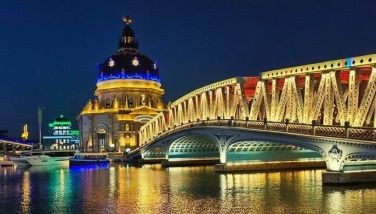Pompeii and the 40 virgins
January 30, 2005 | 12:00am
No visit to Southern Italy would be complete without a visit to Pompeii. Since my wife and I were in the Amalfi Coast, which is in the south and only two hours away from Pompeii, we could not resist its siren call. Since this was my first time there, I was surprised to see that Pompeii is just outside Naples. If it were not for the excavations that have been ongoing there since the 1700s, this area would surely have been swallowed up by Naples’ urban sprawl. Fortunately, the expansion ends at the periphery of Pompeii, thus giving the visitor the distinct impression that he is leaving one world and entering another.
At midday of Aug. 24, 79, Vesuvius exploded with a deafening noise. Before the explosion, the volcano was simply known as the mountain and people had no inkling of its violent past and the danger of living on its slopes. A period of intense seismic activity presaged the disaster. Then, its plug of solidified lava, which had sealed the volcano’s summit, was ripped apart by a 20-kilometer high column of volcanic material. Then came a shower of pumice stones and ash, which enveloped the surroundings in an eerie twilight. This was the harbinger of an incomprehensible cataclysm, which came the next day.
The volcano ejected pyroclastic flow, a dense mixture of rock and gases with temperatures hovering between 200°C to 1000°C and traveling faster than 80 kilometers per hour. It destroyed everything in its path and extinguished the lives of those who remained in Pompeii.
In 1592, an architect, who had been digging a canal in the area, found the ruins of buildings with decorated walls. The find was documented and forgotten until 1748 when excavations began in earnest. The sensational discoveries that followed made a deep impression on contemporary observers and inspired a whole aesthetic, which flowered during the French revolution and the Napoleonic Empire that followed it.
Time stands still in Pompeii. Everything is just as it was when it was buried under ash. The most graphic reminder of this is when visitors chance upon the remains of Pompeii’s inhabitants. Their deaths were so swift that they did not have time to expire. The ghostly shapes that have been unearthed are caught at the moment of death.
Enter the houses and establishments and one almost expects its residents to come out and greet you. Walk along its unevenly paved streets and raised pedestrian flagstones and one may see a slave twist his ankle from the corner of one’s eye. The roads have been so rutted by the endless number of carts and chariots, which have lumbered through these roads, that one can almost feel them ready to run you down. There are loaves of bread left in the ovens of bakeries waiting to be sold. There are even campaign posters advertising candidates for public office in an impending election.
I half expected to see Pompeians sitting in the public toilets or naked in the baths. Or better still, the prostitutes waiting in their cubicles beneath the frescoes advertising their specialties.
Many of the houses in the city were huge even by modern standards. Some occupy a whole city block. Many have beautiful frescoes adorning their walls, especially one very famous house, the House of the Mysteries. Others have bronze statues and fountains, intricate mosaics, porticos, atria and colonnades. Some even had their own bathing complexes so that the owners would not have to patronize the public baths and mingle with the riffraff.
One homeowner, who can only be described as a social climber, had a false colonnade to give the illusion of a large space so he could suitably impress his visitors! One house even had a mosaic floor at its entrance with the warning "Cave canem" (Beware of dogs)!
As I wandered through the town, two thoughts were in my mind. If such a small town in Italy could boast of such wealth, what would the scale and grandeur of the truly wealthy and powerful in Rome have been like? It must have been stupendous.
How could all this wealth and luxury have been achieved and maintained? I realized that the economic base of the entire Roman Empire was slave labor. They had slaves to build and maintain mansions and palaces, stoke the fires, and cool the waters in the baths, build the roads and walls of the city, tend to every whim of their masters, and satiate all their sexual desires and proclivities. Underneath all this power, wealth, and circumstance was an underpinning of misery, which only death could end. And end it did one fine summer day in August 2,000 years ago.
As we wandered about the town, my wife could not help but reminisce about her first visit to Pompeii. She was among a group of 40 young girls (presumably virgins, some no doubt imagined), who went on a world tour sponsored by the Assumption Convent. This was during the time of transatlantic crossings on great passenger ships, a time of formal dinners at the captain’s table, a time of made-to-measure evening clothes, a time of hats and gloves, a time of chaperoned dates, a time of formal manners and debutante balls, a time of half-wit uncles tucked away in an attic or a country house somewhere, a time that, much like in Pompeii, no longer exists. They were escorted by the redoubtable head of the Assumption Convent, she whose dowry was the San Lorenzo campus of the Assumption. When the group came to visit Pompeii, the nuns literally shielded the girls from the more sordid aspects of the city, like the many triple X-rated frescoes found not just in the brothels but in the respectable homes of Pompeii’s aristocrats. It went without saying that the virgins that left Manila would still be virgins when they returned – in dress, in thought and in action.
Naturally, when my wife set foot in Pompeii 40 years later, her first impulse was to see everything she was stopped from viewing on her first trip. So, we went to every brothel and saw every licentious fresco there was to see until she was no longer curious.
Time and memory are inextricably intertwined. Time is absolute, memory, relative. Pompeii is time that has been stopped dead in its tracks, while my wife’s memory of her trip around the world ebb and flow with the intensity of her imagination and is inevitably burnished by the golden glow of nostalgia.
Ghosts still roam the deserted streets of Pompeii. There are the ghosts of those ancient Pompeians who lost their lives that summer day 2,000 years ago and those 40 virgins searching poignantly for their virginity and the simplicity of another age, now irretrievably lost.
At midday of Aug. 24, 79, Vesuvius exploded with a deafening noise. Before the explosion, the volcano was simply known as the mountain and people had no inkling of its violent past and the danger of living on its slopes. A period of intense seismic activity presaged the disaster. Then, its plug of solidified lava, which had sealed the volcano’s summit, was ripped apart by a 20-kilometer high column of volcanic material. Then came a shower of pumice stones and ash, which enveloped the surroundings in an eerie twilight. This was the harbinger of an incomprehensible cataclysm, which came the next day.
The volcano ejected pyroclastic flow, a dense mixture of rock and gases with temperatures hovering between 200°C to 1000°C and traveling faster than 80 kilometers per hour. It destroyed everything in its path and extinguished the lives of those who remained in Pompeii.
In 1592, an architect, who had been digging a canal in the area, found the ruins of buildings with decorated walls. The find was documented and forgotten until 1748 when excavations began in earnest. The sensational discoveries that followed made a deep impression on contemporary observers and inspired a whole aesthetic, which flowered during the French revolution and the Napoleonic Empire that followed it.
Time stands still in Pompeii. Everything is just as it was when it was buried under ash. The most graphic reminder of this is when visitors chance upon the remains of Pompeii’s inhabitants. Their deaths were so swift that they did not have time to expire. The ghostly shapes that have been unearthed are caught at the moment of death.
Enter the houses and establishments and one almost expects its residents to come out and greet you. Walk along its unevenly paved streets and raised pedestrian flagstones and one may see a slave twist his ankle from the corner of one’s eye. The roads have been so rutted by the endless number of carts and chariots, which have lumbered through these roads, that one can almost feel them ready to run you down. There are loaves of bread left in the ovens of bakeries waiting to be sold. There are even campaign posters advertising candidates for public office in an impending election.
I half expected to see Pompeians sitting in the public toilets or naked in the baths. Or better still, the prostitutes waiting in their cubicles beneath the frescoes advertising their specialties.
Many of the houses in the city were huge even by modern standards. Some occupy a whole city block. Many have beautiful frescoes adorning their walls, especially one very famous house, the House of the Mysteries. Others have bronze statues and fountains, intricate mosaics, porticos, atria and colonnades. Some even had their own bathing complexes so that the owners would not have to patronize the public baths and mingle with the riffraff.
One homeowner, who can only be described as a social climber, had a false colonnade to give the illusion of a large space so he could suitably impress his visitors! One house even had a mosaic floor at its entrance with the warning "Cave canem" (Beware of dogs)!
As I wandered through the town, two thoughts were in my mind. If such a small town in Italy could boast of such wealth, what would the scale and grandeur of the truly wealthy and powerful in Rome have been like? It must have been stupendous.
How could all this wealth and luxury have been achieved and maintained? I realized that the economic base of the entire Roman Empire was slave labor. They had slaves to build and maintain mansions and palaces, stoke the fires, and cool the waters in the baths, build the roads and walls of the city, tend to every whim of their masters, and satiate all their sexual desires and proclivities. Underneath all this power, wealth, and circumstance was an underpinning of misery, which only death could end. And end it did one fine summer day in August 2,000 years ago.
As we wandered about the town, my wife could not help but reminisce about her first visit to Pompeii. She was among a group of 40 young girls (presumably virgins, some no doubt imagined), who went on a world tour sponsored by the Assumption Convent. This was during the time of transatlantic crossings on great passenger ships, a time of formal dinners at the captain’s table, a time of made-to-measure evening clothes, a time of hats and gloves, a time of chaperoned dates, a time of formal manners and debutante balls, a time of half-wit uncles tucked away in an attic or a country house somewhere, a time that, much like in Pompeii, no longer exists. They were escorted by the redoubtable head of the Assumption Convent, she whose dowry was the San Lorenzo campus of the Assumption. When the group came to visit Pompeii, the nuns literally shielded the girls from the more sordid aspects of the city, like the many triple X-rated frescoes found not just in the brothels but in the respectable homes of Pompeii’s aristocrats. It went without saying that the virgins that left Manila would still be virgins when they returned – in dress, in thought and in action.
Naturally, when my wife set foot in Pompeii 40 years later, her first impulse was to see everything she was stopped from viewing on her first trip. So, we went to every brothel and saw every licentious fresco there was to see until she was no longer curious.
Time and memory are inextricably intertwined. Time is absolute, memory, relative. Pompeii is time that has been stopped dead in its tracks, while my wife’s memory of her trip around the world ebb and flow with the intensity of her imagination and is inevitably burnished by the golden glow of nostalgia.
Ghosts still roam the deserted streets of Pompeii. There are the ghosts of those ancient Pompeians who lost their lives that summer day 2,000 years ago and those 40 virgins searching poignantly for their virginity and the simplicity of another age, now irretrievably lost.
BrandSpace Articles
<
>



















